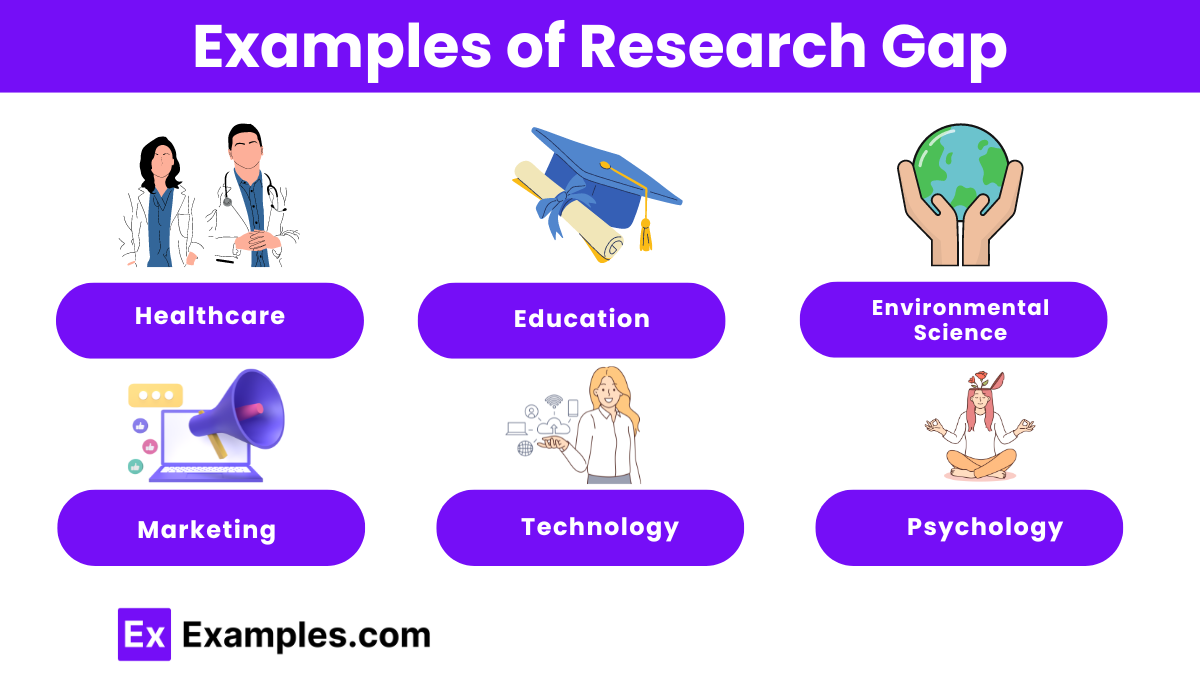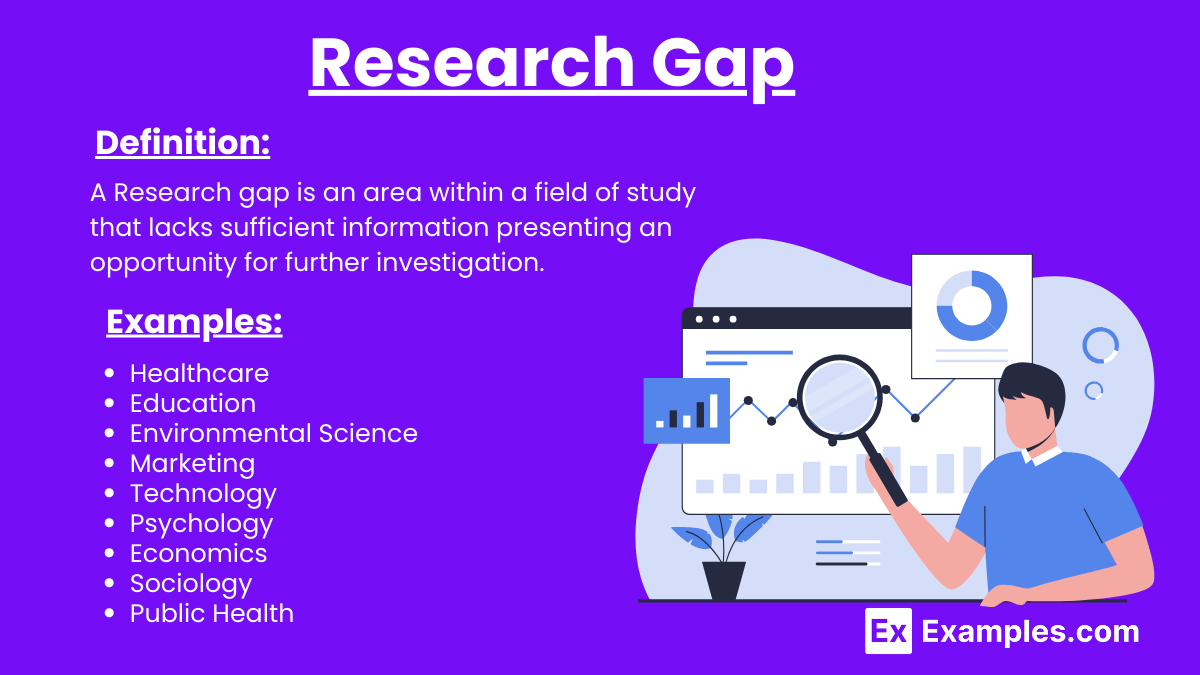10+ Research Gap Examples
A research gap is an area within a field that lacks sufficient information or understanding, highlighting opportunities for further investigation. Identified through literature review, it guides researchers to explore new questions and develop innovative theories. Addressing these gaps advances knowledge and solves real-world problems. In areas like Marketing Gap Analysis, identifying research gaps leads to more effective strategies and improved market performance.
What is a Research Gap?
A research gap is an area within a field of study that lacks sufficient information or understanding, presenting an opportunity for further investigation. It is identified through a thorough review of existing literature and highlights areas where more research is needed. Recognizing these gaps is essential for advancing knowledge, guiding researchers to explore new questions, develop innovative theories, and improve methodologies.
Examples of Research Gap

- Healthcare: Limited studies on the long-term effects of telemedicine on patient outcomes, especially in rural areas.
- Education: Insufficient research on the impact of virtual reality in improving student engagement and learning outcomes in primary education.
- Environmental Science: Lack of comprehensive data on the effects of microplastics on marine ecosystems.
- Marketing: Few studies exploring the influence of social media influencers on consumer behavior in emerging markets.
- Technology: Sparse research on the ethical implications of artificial intelligence in workplace decision-making processes.
- Psychology: Limited understanding of the mental health impacts of prolonged social media use among teenagers.
- Economics: Insufficient analysis of the effects of cryptocurrency adoption on traditional banking systems.
- Sociology: Lack of in-depth studies on the long-term effects of remote work on family dynamics and work-life balance.
- Public Health: Few studies examining the effectiveness of community-based interventions in reducing obesity rates among children.
- Renewable Energy: Limited research on the integration of renewable energy sources into existing power grids and their economic impacts.
Different Types of Research Gaps
Research gaps are areas where knowledge is lacking or where existing research could be expanded. Identifying and addressing these gaps is crucial for advancing knowledge in any field. Here are the different types of research gaps:
1. Evidence Gap
Definition: An evidence gap occurs when there is a lack of empirical data to support conclusions or theories. This gap signifies areas where more research is needed to provide solid evidence for or against a hypothesis.
Example: Limited studies on the long-term effects of a new medication.
2. Knowledge Gap
Definition: A knowledge gap refers to a lack of understanding or awareness about a specific topic. This gap often highlights areas where research has not yet been conducted or where findings are inconsistent.
Example: Insufficient knowledge about the impact of social media on mental health among teenagers.
3. Practical-Knowledge Gap
Definition: This gap arises when there is a disconnect between theoretical research and practical application. It points to areas where findings from research have not been implemented in real-world settings or where practical challenges are not addressed by existing research.
Example: Theoretical models for disaster management that are not tested in actual disaster scenarios.
4. Methodological Gap
Definition: A methodological gap is identified when current research methods are inadequate to address certain research questions. This gap indicates the need for new or improved research methods.
Example: The need for longitudinal studies to better understand the progression of chronic diseases.
5. Policy Gap
Definition: A policy gap occurs when research does not inform policy or when there is a lack of research supporting existing policies. This gap often highlights the need for research that can influence or evaluate policy decisions.
Example: Lack of research on the effectiveness of policies aimed at reducing carbon emissions.
6. Population Gap
Definition: This gap is present when certain populations or demographic groups are underrepresented in research. It calls attention to the need for more inclusive research that considers diverse populations.
Example: Underrepresentation of elderly populations in clinical trials for new medications.
7. Theory Gap
Definition: A theory gap is found when there is a lack of theoretical framework to explain certain phenomena. This gap suggests the need for developing or refining theories to better understand specific issues.
Example: Incomplete theoretical explanations for the rise of extremism in modern societies.
8. Contextual Gap
Definition: A contextual gap exists when research does not take into account the context in which a phenomenon occurs. This gap highlights the need for studies that consider environmental, cultural, or situational factors.
Example: Studies on education methods that do not consider cultural differences in learning styles.
9. Perspective Gap
Definition: This gap arises when certain perspectives or viewpoints are missing from the research. It emphasizes the need for more diverse viewpoints to provide a comprehensive understanding of a topic.
Example: Limited perspectives from minority groups in research on workplace diversity.
10. Data Gap
Definition: A data gap is identified when there is a lack of available data or when existing data is insufficient to support research conclusions. This gap indicates the need for more extensive data collection and analysis.
Example: Insufficient data on climate change impacts in specific geographic regions.
How to write Research Gap
Identifying and articulating a research gap is a crucial step in academic research. It highlights the need for your study and sets the stage for your research question and objectives. Here’s a step-by-step guide on how to write a research gap:
1. Literature Review
Conduct a thorough literature review to understand the current state of research in your field. Look for recent studies, key theories, and significant findings. Take note of any inconsistencies, unanswered questions, or areas that have not been explored.
2. Identify the Gap
After reviewing the literature, pinpoint the specific areas where research is lacking. This could be due to insufficient evidence, outdated studies, contradictory findings, or unaddressed issues.
3. Justify the Gap
Explain why this gap is important. Discuss the implications of not addressing this gap and how filling it could advance knowledge in your field or solve a practical problem.
4. Formulate Your Research Question
Based on the identified gap, formulate a clear and focused research question. This question should aim to address the gap and guide your study.
5. Contextualize the Gap
Place your research gap within the broader context of your field. Explain how your study will contribute to the existing body of knowledge and why it is timely and relevant.
6. Use Clear and Concise Language
When writing about the research gap, be clear and concise. Avoid jargon and ensure that your explanation is understandable to readers outside your immediate field.
How to Identify Research Gap?
Identifying a research gap is essential for developing a relevant and impactful research question. Here are the steps to effectively identify a research gap:
1. Conduct a Comprehensive Literature Review
Start by thoroughly reviewing existing literature in your area of interest. Use academic databases, journals, books, and conference papers to gather information. Focus on:
- Recent studies and their findings
- Key theories and models
- Methodologies used
- Areas of consensus and disagreement
2. Analyze the Literature Critically
While reviewing the literature, critically evaluate the studies. Look for:
- Inconsistencies: Contradictory findings or conclusions
- Outdated Information: Studies that need updating due to new data or advancements
- Methodological Flaws: Weaknesses or limitations in research methods
- Unanswered Questions: Questions that previous studies have raised but not answered
3. Identify Trends and Patterns
Identify trends and patterns in the existing research. Consider:
- Common themes and topics
- Frequently used methodologies
- Populations and settings studied
- Gaps in data and analysis
4. Look for Understudied Areas
Identify topics or subtopics that have not been extensively researched. Pay attention to:
- Emerging fields or new technologies
- Neglected populations or regions
- Interdisciplinary research opportunities
5. Consult Reviews and Meta-Analyses
Review articles and meta-analyses can provide a summary of the current state of research and highlight areas where further research is needed. They often suggest future research directions and gaps.
6. Analyze Research Agendas and Funding Opportunities
Research agendas and funding calls from academic institutions, government agencies, and private organizations can highlight priority areas and identify gaps that need addressing.
7. Discuss with Experts and Peers
Engage in discussions with experts, mentors, and peers in your field. They can provide insights into current research trends and gaps that you might have overlooked.
8. Examine Conference Proceedings
Conference proceedings often contain the latest research and can indicate emerging trends and gaps. Attend conferences and review the abstracts and presentations.
9. Evaluate the Practical Relevance
Consider the practical implications of existing research. Identify areas where research findings have not been applied or where practical challenges remain unaddressed.
10. Formulate Research Questions
Based on the identified gaps, develop specific research questions. These questions should address the gaps and guide your research towards filling them.
Research Gap Uses
1. Advancing Knowledge
Filling a research gap helps in advancing the overall knowledge within a field. It allows researchers to build upon existing studies and contribute new insights, theories, or methods.
2. Innovative Solutions
Addressing a research gap can lead to the development of innovative solutions to existing problems. Researchers can explore new approaches, technologies, or applications that have not been previously considered.
3. Funding and Support
Identifying a significant research gap can attract funding and support from academic institutions, government bodies, and private organizations. Funders are often interested in supporting projects that promise new discoveries and advancements.
4. Publishing Opportunities
Research that addresses a gap is often seen as valuable and original, increasing the chances of publication in reputable academic journals. This can enhance the researcher’s profile and credibility within the academic community.
5. Educational Development
For educators and students, identifying research gaps can guide the development of curricula and educational programs. It ensures that teaching materials are up-to-date and relevant to current academic and industry trends.
FAQ’s
Why is identifying a research gap important?
Identifying a research gap helps focus efforts on unexplored areas, advancing knowledge and contributing to the field.
How can I identify a research gap?
Review current literature, analyze findings, and note areas lacking comprehensive studies or conflicting results.
What are the types of research gaps?
Types include evidence gaps, knowledge gaps, practical gaps, theoretical gaps, and methodological gaps.
What is an evidence gap?
An evidence gap exists when there is a lack of empirical data supporting a particular hypothesis or theory.
How does a theoretical gap differ from a practical gap?
A theoretical gap involves missing or underdeveloped concepts, while a practical gap involves real-world issues needing solutions.
What is a methodological gap?
A methodological gap arises when certain methods have not been applied to study a specific problem.
How can conflicting results indicate a research gap?
Conflicting results suggest inconsistencies in findings, pointing to areas needing further investigation.
What is the role of a literature review in identifying research gaps?
A literature review helps identify gaps by summarizing existing studies and highlighting areas needing further research.
Can technology advancements create research gaps?
Yes, new technologies can reveal gaps by enabling studies that were previously impossible or overlooked.
What is the impact of research gaps on funding opportunities?
Identifying significant gaps can attract funding by demonstrating the need for research in unexplored areas.



